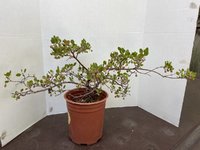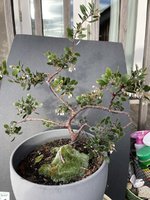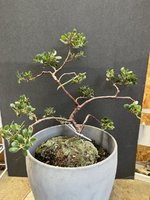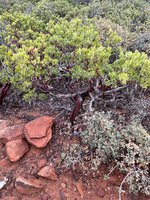You are using an out of date browser. It may not display this or other websites correctly.
You should upgrade or use an alternative browser.
You should upgrade or use an alternative browser.
Manzanita
- Thread starter Yosemite
- Start date
Bonsai Nut
Nuttier than your average Nut
I have tried several different mazanita species while in SoCal. You can usually buy 6-8 different types at Tree of Life Nursery on Ortega Freeway.
My takeaways:
(1) They have really sensitive roots. If you don't touch the roots, the rest is easy
(2) They will crash if you use an acid fertilizer on them. They really seem to need alkaline soil and react quite negatively to a change in soil pH - while other plants given the same treatment (to the left and right of them on the bench) will thrive.
I have kept them for several years, but they crash quite easily. They are a genus that thrives on neglect. I wish I knew the secret, but it eludes me.
My takeaways:
(1) They have really sensitive roots. If you don't touch the roots, the rest is easy
(2) They will crash if you use an acid fertilizer on them. They really seem to need alkaline soil and react quite negatively to a change in soil pH - while other plants given the same treatment (to the left and right of them on the bench) will thrive.
I have kept them for several years, but they crash quite easily. They are a genus that thrives on neglect. I wish I knew the secret, but it eludes me.
thanks for the tips folks...
All I've done since collecting them is to water them, and even that's been pretty sparse...summer is like a desert up here,it's been in the 90s the past couple days....I've just kept them in the nasty decomposed granite dirt I dug them out with...weird little buggers, the soil around here seems to kill just about anything except weeds but I figured my best shot was to not disturb their roots much when I dug them up even though a good bit of it was my driveway's gravel... I fear any "improved" soil would be lethal.... they're a fun change from all my acid peat bog, standing water needing carnivores
All I've done since collecting them is to water them, and even that's been pretty sparse...summer is like a desert up here,it's been in the 90s the past couple days....I've just kept them in the nasty decomposed granite dirt I dug them out with...weird little buggers, the soil around here seems to kill just about anything except weeds but I figured my best shot was to not disturb their roots much when I dug them up even though a good bit of it was my driveway's gravel... I fear any "improved" soil would be lethal.... they're a fun change from all my acid peat bog, standing water needing carnivores
oddirt
Mame
Nice! I hope they continue to do well. Great Saraccenia growing in the background, too. They look really healthy.quick update... 2 months have passed and both plants are still healthy, so fingers crossed some gentle nudging toward becoming bonsai may be possible next yearView attachment 305706
thanks.... sarracenia I have down and have for a quarter century... bonsai are more challengingNice! I hope they continue to do well. Great Saraccenia growing in the background, too. They look really healthy.
Shima
Omono
The deer?I’ve had to cage them ‘til they’re tall enough.
oddirt
Mame
Manzanita information is scarce. The best article I have come across is one written by Tom Kelly, it incorporates responses from Greg Brenden, noting his experience with successfully collecting and maintaining manzanita in Arizona. Golden Statements, Vol XXVII No 5. The article is nine pages long and contains some very useful information. October 2004.
Thanks for abstracting the article, Frank. GSBF no longer has archives of GS before 2016 on their website. I did find the article on an odd RSS feed archive site, attached here as PDF. The links to photos don't work as they're trying to go to the original GSBF website. Here's the website too, but who knows how long it will stay up? http://bonsai115.rssing.com/chan-13665455/all_p5.html
Attachments
oddirt
Mame
The deer?
Good to know the grammarati are alive on this site. As a lit major, I should have known better. Or, maybe I like my venison fresh. By the way, do you have a scan of the GSBF article that you mentioned you're in? I haven't been able to find it online.
River's Edge
Masterpiece
We planted Kinnickinnick as a ground cover to control erosion on slopes beside our road down to the meadow. Works really well as it is a rocky, sandy slope with full sun exposure to the south/west.Thank you Frank for info. So interesting, so difficult. Almost a holy grail of species for Bonsai. Currently looking avariciously at landscape Kinnickinnick. Same great bark somewhat easier of culture perhaps?
Smoke
Ignore-Amus
The first two pictures in this collection are pictures I took. The big one is from a GSBF show in So. Cal. and belongs to Lindsey Shiba. It was half dead in the show and I have a picture of it in much better shape somewhere on film. The second photo is from a BIB show and the tree belongs to Greg Brendon. I do not know if either tree is still alive.I’ve been collecting info on Manzanita bonsai. Here is some of my findings:
Manzanita Thread
Arctostaphylos - Manzanita
Threads on a couple of similar species:
Kinnickinnick
Madrone (Arbutus)
Some notes from Bonsainut, but did not save who they are attributed to (so sorry!):
I'm finding the key to successfully keeping manzanita happy in a bonsai pot is giving the roots plenty of room as indeeper pot. They also don't like to have thicker woody roots removed or cut back. The tree in this post has woody roots at the bottom of the pot; I tried to preserve as many roots when I dug as I possibly could. I think I'll let this go one more season before I re-pot it as I initially potted it in pumice, akadama and lave in equal proportions. It's also important to feed them well through the growing season, which for here was kind of late this year. It didn't open buds until June, but grew strongly through the summer. I fertilized it with organic cake type fertilizer.
Collect Manzanita off of rocks where they are in situations that you can get the whole root system. Usually these trees grow on rocks with a shallow pocket of dirt where you can scoop the tree up getting the whole shallow system.
Manzanita are notoriously finicky if you mess with their roots, and they require free-draining soil that is low in organic material. Additionally they regularly die back, even when healthy, leaving dead branches and shari on the tree - even if it is relatively young. They also have very hard wood - slightly harder than hard maple - so they are extremely difficult to style once the wood has set.
I have two different species I am currently working with. I managed to kill (almost instantly) individuals of both species when I applied acid fertilizer to them (in the same strength that my conifers and maples love). I am being careful to keep the soil alkaline going forward.
And finally, some photos of bonsai:
View attachment 292090View attachment 292091
View attachment 292092
View attachment 292093View attachment 292094View attachment 292095
View attachment 292096
View attachment 292097
Some Arbutus:
View attachment 292098
View attachment 292099
Shima
Omono
I don't have a scan. Perhaps I should do that. My copy is loaned out at the moment. The title is: "Bonsai on the Big Island."Good to know the grammarati are alive on this site. As a lit major, I should have known better. Or, maybe I like my venison fresh. By the way, do you have a scan of the GSBF article that you mentioned you're in? I haven't been able to find it online.
I first fell in love with manzinata in Zion National Park. I didn’t know what it was at the time. There are now a few commercially available kinds of manzinata that tend to be low shrubs. They are most commercially available along the Colorado front range. I now have 9 Manzinata Panchito growing in my northern Utah yard. I’m currently waiting until April to see if this last summer’s ground layers worked. I would love to make some very small trees or cascades out of them. My plants are in my Xerces areas of the yard. they get watered from every three weeks to three times per summer depending where they are in the yard. They grow faster where they get more water. My soil is a sandy loam with pH 7.9.
Atrox
Mame
rowan of appalachia
Seedling
Old thread but if y’all are planning on trying this more, you’ll have the most success with species derived from A. edmundsii and uva-ursi. Both inhabit rich souls, are not as finicky about overwatering, and both but uva-ursi especially tolerate pruning more than other species. There are several cultivars of each. If you live in a hot climate you’re actually going to want to prune in the late summer, between waterings. Arctostaphylos are vulnerable to a branch dieback fungus that prefers moist conditions. This will still allow for maximum flowering.
Debbieo
Seed
- Messages
- 1
- Reaction score
- 1
Hello,Hi folks.
Quick introduction... I used to have a nice small collection of bonsai for many years but lost all of them in the hot summer to a family emergency in 2006.Several species of my large carnivorous plant collection made it but swamp plants in deep tubs of water are more forgiving of neglect than trees in shallow pots.
Now with the virus keeping me mostly at home I have attempt number one in a pot.I know it's said to be nearly impossible by some to pull off collected manzanita but there is a method to my madness.First,it's free in my yard.Second, I've been watching this little bugger since it first showed up at the edge of my driveway a couple years ago and third, it came out with all it's roots,I kept the bad soil it was growing in including the driveway gravel.Third, it's already used to our brutal California summer.
I look forward to very slowly starting a few "normal" bonsai in the coming years enjoying the pictures and tips and learning from all the people on this forum.
View attachment 291767
Not sure if I’m posting this right. My apologies if not. I bought this Manzanita in May


 of 2021 at a small mom and pop nursery. It’s a California native but otherwise I don’t know the species. Here is a small progression of the plant. Constructive critique is welcome. I’m worried about it getting too leggy. Not sure when and how much to take off.
of 2021 at a small mom and pop nursery. It’s a California native but otherwise I don’t know the species. Here is a small progression of the plant. Constructive critique is welcome. I’m worried about it getting too leggy. Not sure when and how much to take off.leatherback
The Treedeemer
Such a cool species! I saw them in Mexico a few years back. Would love to have a mature specimentJust discovered this species on a hike in Sedona, Arizona. Wish I could have taken some home.



